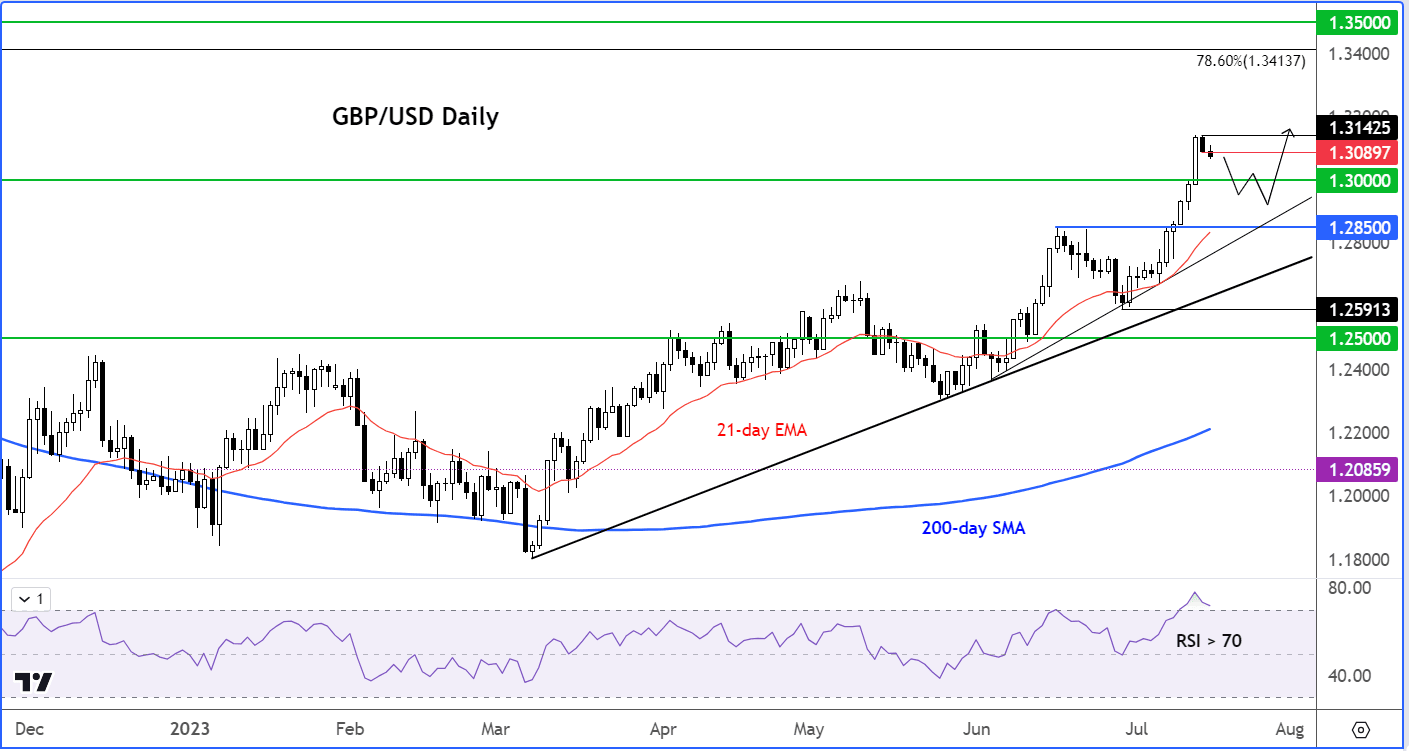Traders Lighten Pound Sterling Exposure Ahead of CPI Release, Comes Off Highs against Euro and Dollar
- Written by: Gary Howes
-

Image © Adobe Images
As is often the case ahead of potentially major market-moving events, traders opted to cut back exposure to the British Pound in the lead-up to the midweek UK inflation release.
Although the Pound remains 2023's top gainer amongst the world's major currencies, the Pound to Euro exchange rate has eased 1.0% from the previous week's multi-month high at 1.1760 to 1.1650.
The Pound to Dollar exchange rate is two-thirds of a per cent off the 14-month highs, just above 1.31, and is back at 1.3077. GBPUSD entered the new week looking oversold on a technical basis and prone to a pullback to allow these conditions to unwind somewhat.
"Sterling profit taking overdue after GBP/USD reaches most overbought levels since February 2020. Seasonality turns negative in August," says Kenneth Broux, a strategist at Société Générale.
Nevertheless, technical analysts hold a view the upside trend remains intact and dips will continue to be bought.
"Recent inflation numbers have surprised to the upside, leading markets to reprice more pound-positive rate hikes from the Bank of England. Should inflation again surprise higher, it could catalyze further sterling appreciation by bolstering the case for a second straight 50 basis point hike by the BOE in early August," says Joe Manimbo, Senior Currency Analyst at Convera.
CPI is expected by the market to have risen 8.2% year-on-year in June, down from 8.7% previously, with core inflation expected to have fallen to 6.8% from 7.1%.
Sterling could come under pressure if inflation data undershoot on Wednesday in a development that would push UK bond yields lower, in turn making Sterling assets less attractive to foreign investors.
"Below forecast inflation and retail sales would temper the hawkish repricing of the outlook for bank rate and cause front-end Gilt yields to take a step back. The OIS curve is discounting 43bp next month and another 35bp in September. Profit taking in GBP/USD would nudge EUR/GBP back over 0.86," says Broux.
Those watching the Pound should be aware that the UK currency failed to appreciate in the wake of the above-consensus inflation release of June, suggesting a hotter-than-expected reading could also degrade Pound Sterling value.
The thinking here is that higher interest rates at the Bank of England - the Bank raises rates to fight inflation - could undermine UK economic activity and spark a recession that is ultimately negative for the Pound.
"While rate differentials have driven the GBP higher in recent weeks, the UK faces a heightened risk of a recession in H2 as the BoE drives rates higher to quell demand and bring inflation back to its 2% target," says Rajat Bhattacharya, an analyst at Standard Chartered.
Standard Chartered said in a note it is "turning short-term bearish on GBP."
Above: GBPUSD technical studies show an entrenched uptrend. Image courtesy of City Index.
Parisha Saimbi, G10 FX Strategist at BNP Paribas, says the UK's high inflation rates leave her bearish on the Pound's prospects and she targets Pound-Dollar back at 1.21 by year-end and 0.87 for Euro-Pound (1.15 for Pound-Euro).
"Underlying data suggest upward pressure on demand. In May, the 3m/3m employment change was above expectations again and earnings also came in above forecasts, suggesting price pressures could persist. This reinforces our call for further policy-rate hikes, but ultimately this will materially slow the economy," says Saimbi.
If too much inflation is not necessarily supportive of the Pound's outlook, then surely an undershoot in this month's release can prove supportive?
This could be the case if UK real yields (nominal yields minus inflation) are supported; some analysts argue that what matters most to investors is the real yield they receive and not the nominal yield on paper.
However, the sharp fall in the U.S. Dollar in response to last week's undershoot in U.S. inflation shows falling inflation and yields can undercut a currency, ensuring predicting the FX response to this week's inflation is rather tricky.
Above: Potential downside levels that could be tested this week if inflation data goes against the Pound. More information on this here.
Money markets show investors are now positioned for another 50 basis point hike at the Bank of England's August meeting as the Bank looks to restore credibility and get on the front foot in terms of managing UK inflation expectations.
For this reason, analysts at Barclays are constructive on the Pound's prospects.
"We have turned more positive on the GBP in the near term, particularly in crosses, but also EURGBP, relative to our previous forecasts. The recent 50bp surprise hike by the MPC points to a more proactive stance against inflation, which we think is long overdue," says the Barclays FX strategy team in a weekly briefing.
Analysts at the bank acknowledge further hikes in interest rates could ultimately weigh on growth, but argue the UK's inflation problem is a symptom of resilient demand amid tight labour markets and reduced aggregate supply.
"As such, higher rates are enhancing sterling’s already considerable carry advantage, even as the bar for further hawkish surprises relative to market pricing is now quite high," says Barclays.







